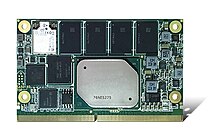
A graphics card is a computer expansion card that generates a feed of graphics output to a display device such as a monitor. Graphics cards are sometimes called discrete or dedicated graphics cards to emphasize their distinction to integrated graphics processor on the motherboard or the CPU. A graphics processing unit (GPU) that performs the necessary computations is the main component in a graphics card, but the acronym "GPU" is sometimes also used to erroneously refer to the graphics card as a whole.

PCI Express, officially abbreviated as PCIe or PCI-e, is a high-speed serial computer expansion bus standard, designed to replace the older PCI, PCI-X and AGP bus standards. It is the common motherboard interface for personal computers' graphics cards, sound cards, hard disk drive host adapters, SSDs, Wi-Fi and Ethernet hardware connections. PCIe has numerous improvements over the older standards, including higher maximum system bus throughput, lower I/O pin count and smaller physical footprint, better performance scaling for bus devices, a more detailed error detection and reporting mechanism, and native hot-swap functionality. More recent revisions of the PCIe standard provide hardware support for I/O virtualization.

GeForce is a brand of graphics processing units (GPUs) designed by Nvidia and marketed for the performance market. As of the GeForce 40 series, there have been eighteen iterations of the design. The first GeForce products were discrete GPUs designed for add-on graphics boards, intended for the high-margin PC gaming market, and later diversification of the product line covered all tiers of the PC graphics market, ranging from cost-sensitive GPUs integrated on motherboards, to mainstream add-in retail boards. Most recently, GeForce technology has been introduced into Nvidia's line of embedded application processors, designed for electronic handhelds and mobile handsets.

ATI Technologies Inc., commonly called ATI, was a Canadian semiconductor technology corporation based in Markham, Ontario, that specialized in the development of graphics processing units and chipsets. Founded in 1985, the company listed publicly in 1993 and was acquired by AMD in 2006. As a major fabrication-less or fabless semiconductor company, ATI conducted research and development in-house and outsourced the manufacturing and assembly of its products. With the decline and eventual bankruptcy of 3dfx in 2000, ATI and its chief rival Nvidia emerged as the two dominant players in the graphics processors industry, eventually forcing other manufacturers into niche roles.

A graphics processing unit (GPU) is a specialized electronic circuit initially designed to accelerate computer graphics and image processing. After their initial design, GPUs were found to be useful for non-graphic calculations involving embarrassingly parallel problems due to their parallel structure. Other non-graphical uses include the training of neural networks and cryptocurrency mining.

Alienware Corporation is an American computer hardware subsidiary brand of Dell. Their product range is dedicated to gaming computers and can be identified by their alien-themed designs. Alienware was founded in 1996 by Nelson Gonzalez and Alex Aguila. The development of the company is also associated with Frank Azor, Arthur Lewis, Joe Balerdi, and Michael S. Dell. The company's corporate headquarters is located in The Hammocks, Miami, Florida.

Scalable Link Interface (SLI) is the brand name for a now discontinued multi-GPU technology developed by Nvidia for linking two or more video cards together to produce a single output. SLI is a parallel processing algorithm for computer graphics, meant to increase the available processing power.

AMD CrossFire is a brand name for the multi-GPU technology by Advanced Micro Devices, originally developed by ATI Technologies. The technology allows up to four GPUs to be used in a single computer to improve graphics performance.
The AMD 700 chipset series is a set of chipsets designed by ATI for AMD Phenom processors to be sold under the AMD brand. Several members were launched in the end of 2007 and the first half of 2008, others launched throughout the rest of 2008.
AMD FireStream was AMD's brand name for their Radeon-based product line targeting stream processing and/or GPGPU in supercomputers. Originally developed by ATI Technologies around the Radeon X1900 XTX in 2006, the product line was previously branded as both ATI FireSTREAM and AMD Stream Processor. The AMD FireStream can also be used as a floating-point co-processor for offloading CPU calculations, which is part of the Torrenza initiative. The FireStream line has been discontinued since 2012, when GPGPU workloads were entirely folded into the AMD FirePro line.
AMD PowerPlay is the brand name for a set of technologies for the reduction of the energy consumption implemented in several of AMD's graphics processing units and APUs supported by their proprietary graphics device driver "Catalyst". AMD PowerPlay is also implemented into ATI/AMD chipsets which integrated graphics and into AMD's Imageon handheld chipset, that was sold to Qualcomm in 2008.

HP TouchSmart is a series of tablet PC laptops and touchscreen all-in-one desktop computers designed by HP. It features various Intel or AMD processors and runs Windows Vista or Windows 7 as standard.
Sony has used the Z model naming scheme for its high-end ultraportable notebook computers since 2000. Unlike other Sony models, the Z has always been manufactured in Japan or in the United States for some models. Sony stated that production of the Z series would cease at the end of 2012.

The VaioS series was a line of notebook computers from Sony introduced in summer 2004. They have been touted as business laptops, and their designs have focused on being thin and light. They also have features friendly to businesspeople, such as TPM chips, matte (anti-glare) displays, RAID SSDs, and extended sheet batteries, as well as continuing to include RJ-45 and VGA (D-Sub) connections.
EVGA Corporation is an American computer hardware company that produces motherboards, gaming laptops, power supplies, all-in-one liquid coolers, computer cases, and gaming mice. Founded on April 13, 1999, its headquarters are in Brea, California. EVGA also produced Nvidia GPU-based video cards until 2022.
The HP Envy is a line of consumer-oriented high-end laptops, desktop computers and printers manufactured and sold by HP Inc. They started as a high-end version of the HP Pavilion line.
G-Sync is a proprietary adaptive sync technology developed by Nvidia aimed primarily at eliminating screen tearing and the need for software alternatives such as Vsync. G-Sync eliminates screen tearing by allowing a video display's refresh rate to adapt to the frame rate of the outputting device rather than the outputting device adapting to the display, which could traditionally be refreshed halfway through the process of a frame being output by the device, resulting in screen tearing, or two or more frames being shown at once. In order for a device to use G-Sync, it must contain a proprietary G-Sync module sold by Nvidia. AMD has released a similar technology for displays, called FreeSync, which has the same function as G-Sync yet is royalty-free.

The GeForce 30 series is a suite of graphics processing units (GPUs) designed and marketed by Nvidia, succeeding the GeForce 20 series. The GeForce 30 series is based on the Ampere architecture, which features Nvidia's second-generation ray tracing (RT) cores and third-generation Tensor Cores. Through Nvidia RTX, hardware-enabled ray tracing is possible on GeForce 30 series cards.

SXM is a high bandwidth socket solution for connecting Nvidia Compute Accelerators to a system. Each generation of Nvidia Tesla since P100 models, the DGX computer series and the HGX boards come with an SXM socket type that realizes high bandwidth, power delivery and more for the matching GPU daughter cards. Nvidia offers these combinations as an end-user product e.g. in their models of the DGX system series. Current socket generations are SXM for Pascal based GPUs, SXM2 and SXM3 for Volta based GPUs, SXM4 for Ampere based GPUs, and SXM5 for Hopper based GPUs. These sockets are used for specific models of these accelerators, and offer higher performance per card than PCIe equivalents. The DGX-1 system was the first to be equipped with SXM-2 sockets and thus was the first to carry the form factor compatible SXM modules with P100 GPUs and later was unveiled to be capable of allowing upgrading to SXM2 modules with V100 GPUs.
















